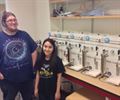
In a move that will save the campus money, improve campus safety and help save the environment, Professor Jason Hein set up a new solvent purification system.
This project is similar to his previous efforts to reduce hazardous waste generated by his lab by capturing and recycling acetone.
The UC Merced provost’s office approved spending $42,000 to purchase the six-tank purification-and-drying system that cleans chemical solvents, providing high purity, water-free solvents for research. This system stores the solvent and cleans the impurities using rechargeable cartridges packed with zeolite or activated alumina.
“It’s like a beer keg meets a Brita water filter,” Hein said. “It’s basically a zero-waste system.”
The bench-top filtration system is one more way UC Merced is demonstrating its commitment to sustainability and environmentally responsible practices.
 Wet labs need high-purity solvents to perform experiments or materials synthesis, but they are expensive to buy, and once opened, become impure and unusable. If a researcher buys a gallon and only needs an ounce for the first use, the rest is wasted.
Wet labs need high-purity solvents to perform experiments or materials synthesis, but they are expensive to buy, and once opened, become impure and unusable. If a researcher buys a gallon and only needs an ounce for the first use, the rest is wasted.
The other common system research labs adopt is to set up dedicated glass solvent stills. But those require large fume-hood space and mean large quantities of flammable solvent are stored over highly reactive compounds such as sodium metal or calcium hydride.
“Many disastrous lab accidents can be attributed to improper handling and usage of lab stills. This system represents a major safety improvement for our campus,” Hein said.
The purification system, which uses pressurized argon gas to drive solvent through the cartridge, can save campus labs thousands of dollars in solvent costs alone.
“Our annual anhydrous solvent expenditure was on the order of $2,000 last year and is expected to increase,” Hein said. “This system represents a major cost and time savings.”
Plus, because the used cartridges go back to the manufacturer for cleaning and recharge, the campus will no longer have the cost of storing and disposing of the hazardous waste from many solvents.
Last fall, Hein began using a cleaning system for acetone, one of the most used solvents in his chemistry lab. The new system now holds anhydrous methylene chloride; dimethyl formamide; tetrahydrofuran; acetonitrite; toluene; and diethylether.
Hein said the unit will most likely be used by other chemists, materials science researchers and those who conduct spectroscopy. Anyone who wants to use the system should contact Hein – high-volume users will be asked to chip in to cover costs.
The new system is expandable, depending on campus needs, with each unit costing about $7,000.
“This is a much, much better option than the others,” Hein said.
Lorena Anderson

Senior Writer and Public Information Representative
Office: (209) 228-4406
Mobile: (209) 201-6255






